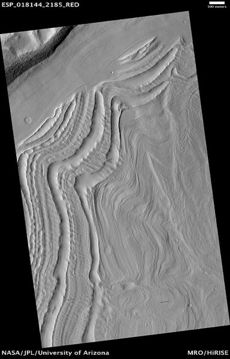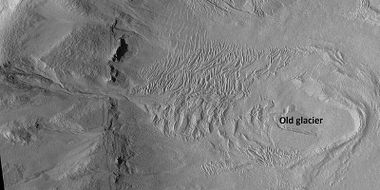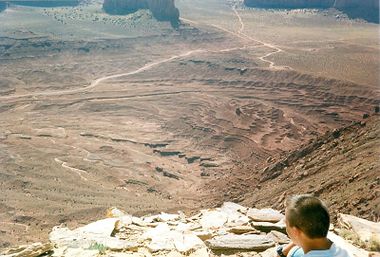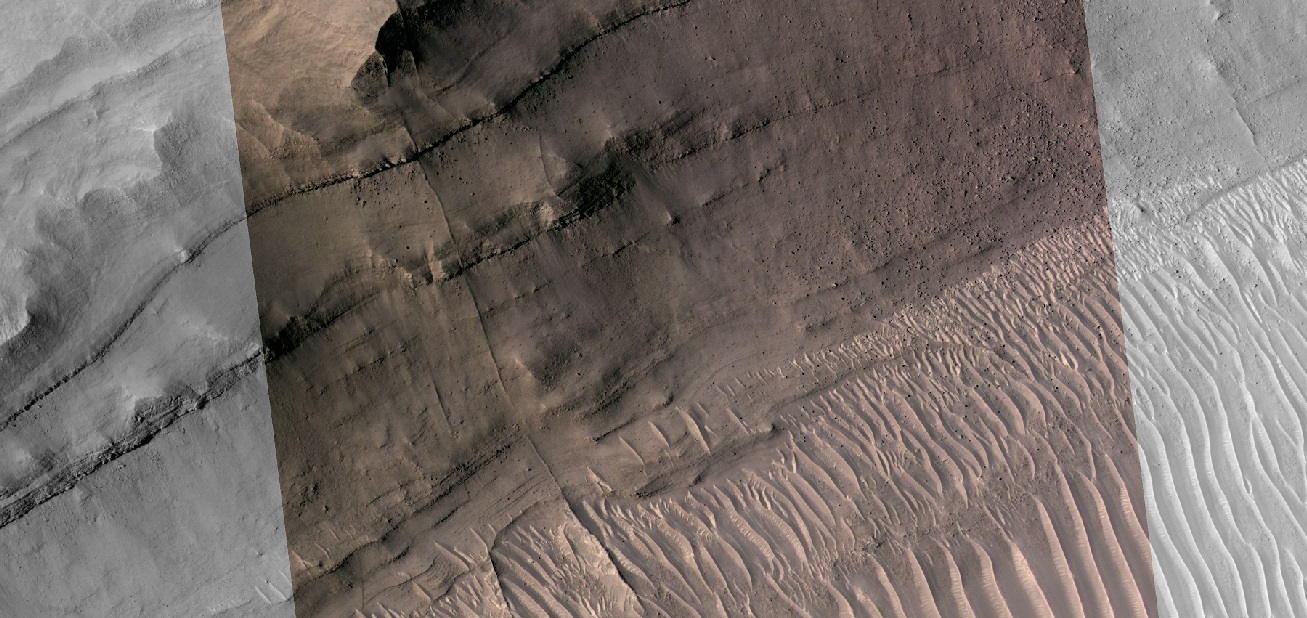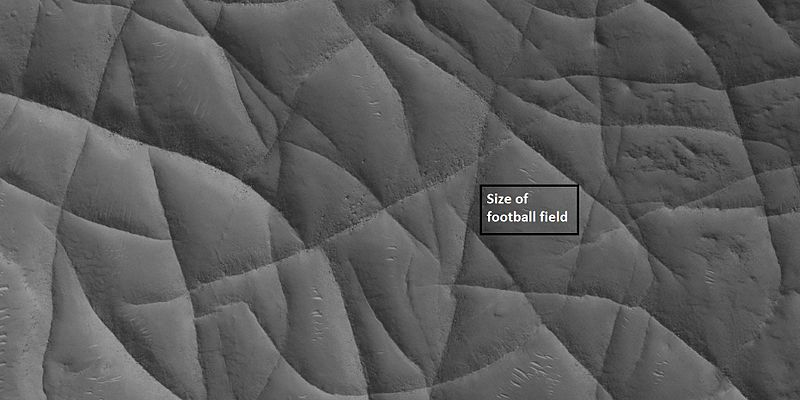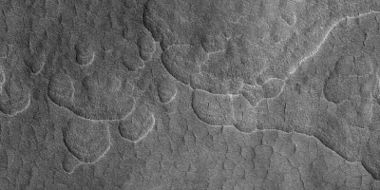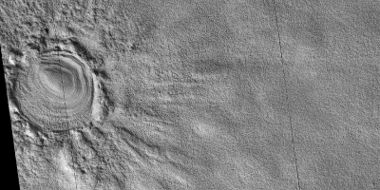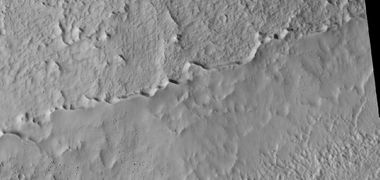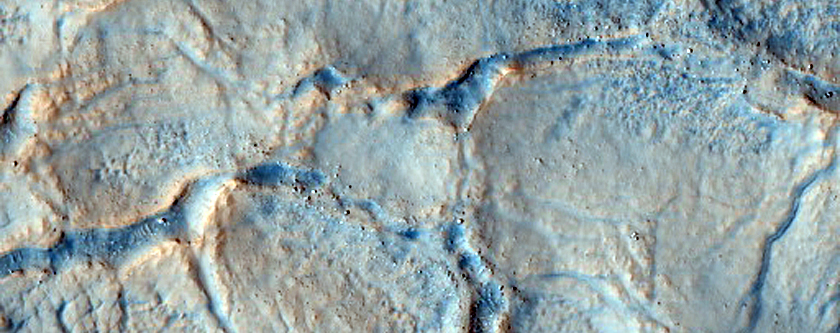Difference between revisions of "Casius quadrangle"
Suitupshowup (talk | contribs) (added image) |
|||
| (24 intermediate revisions by 2 users not shown) | |||
| Line 14: | Line 14: | ||
</gallery> | </gallery> | ||
| − | The Casius quadrangle shows many features that indicate a water-rich past and much ice frozen in the ground. | + | |
| + | |||
| + | [[File:Collage casius.jpg|Features of casius quadrangle, as seen by HiRISE under under HiWish program|600pxr| Features of Casius quadrangle]] | ||
| + | |||
| + | Scenes of the Casius quadrangle | ||
| + | |||
| + | |||
| + | The Casius quadrangle shows many features that indicate a water-rich past and much ice currently frozen in the ground. Features that are evidence of ice in the ground are pedestal craters, channels, glaciers, concentric crater fill, ring-mold craters, scalloped terrain, and polygonal ground. This region also has some landscapes that are mysteries--like strange, but beautiful linear ridge networks. | ||
| + | |||
| + | In this article, some of the best pictures from a number of spacecraft will show what the landscape looks like in this region. The origins and significance of all features will be explained as they are currently understood. | ||
| + | |||
The Casius quadrangle is one of a series of 30 quadrangle maps of Mars used by the United States Geological Survey (USGS). The quadrangle is located in the northern hemisphere and covers 30° to 65° north latitude and 240° to 300° west longitude (120° to 60° east longitude). It is also described as MC-6 (Mars Chart-6).<ref>Davies, M.E.; Batson, R.M.; Wu, S.S.C. "Geodesy and Cartography" in Kieffer, H.H.; Jakosky, B.M.; Snyder, C.W.; Matthews, M.S., Eds. ''Mars.'' University of Arizona Press: Tucson, 1992.</ref> Casius quadrangle contains part of Utopia Planitia and a small part of Terra Sabaea. | The Casius quadrangle is one of a series of 30 quadrangle maps of Mars used by the United States Geological Survey (USGS). The quadrangle is located in the northern hemisphere and covers 30° to 65° north latitude and 240° to 300° west longitude (120° to 60° east longitude). It is also described as MC-6 (Mars Chart-6).<ref>Davies, M.E.; Batson, R.M.; Wu, S.S.C. "Geodesy and Cartography" in Kieffer, H.H.; Jakosky, B.M.; Snyder, C.W.; Matthews, M.S., Eds. ''Mars.'' University of Arizona Press: Tucson, 1992.</ref> Casius quadrangle contains part of Utopia Planitia and a small part of Terra Sabaea. | ||
| Line 39: | Line 49: | ||
<gallery class="center" widths="380px" heights="360px"> | <gallery class="center" widths="380px" heights="360px"> | ||
| − | |||
| Line 45: | Line 54: | ||
File:55026 2220polygonscolor.jpg|Close, color view of polygonal ground | File:55026 2220polygonscolor.jpg|Close, color view of polygonal ground | ||
| − | File:53562 2235patternedground2.jpg|Large and small polygonal ground | + | File:53562 2235patternedground2.jpg|Large and small polygonal ground Area with small, low-center polygons is labeled. |
</gallery> | </gallery> | ||
| Line 52: | Line 61: | ||
| − | 44042 2240highlowcenters.jpg|High and low center polygons | + | 44042 2240highlowcenters.jpg|High and low center polygons |
</gallery> | </gallery> | ||
| Line 67: | Line 76: | ||
==Ring mold craters== | ==Ring mold craters== | ||
| − | Ring mold craters look like the ring molds used in baking. A popular idea for their formation is an impact into ice. The ice is covered by a layer of debris. They are found in parts of Mars that have buried ice. Laboratory experiments confirm that impacts into ice result in a "ring mold shape."<ref>Kress, A., J. Head. 2008. Ring-mold craters in lineated valley fill and lobate debris aprons on Mars: Evidence for subsurface glacial ice. Geophys.Res. Lett: 35. L23206-8</ref><ref>Baker, D. et all. 2010. Flow patterns of lobate debris aprons and lineated valley fill north of Ismeniae Fossae, Mars: Evidence for extensive mid-latitude glaciation in the Late Amazonian. Icarus: 207. 186-209</ref> <ref>Kress., A. and J. Head. 2009. Ring-mold craters on lineated valley fill, lobate debris aprons, and concentric crater fill on Mars: Implications for near-surface structure, composition, and age. Lunar Planet. Sci: 40. abstract 1379</ref> | + | Ring mold craters look like the ring molds used in baking. A popular idea for their formation is an impact into ice. The ice is covered by a layer of debris. They are found in parts of Mars that have buried ice. Laboratory experiments confirm that impacts into ice result in a "ring mold shape."<ref>Kress, A., J. Head. 2008. Ring-mold craters in lineated valley fill and lobate debris aprons on Mars: Evidence for subsurface glacial ice. Geophys.Res. Lett: 35. L23206-8</ref><ref>Baker, D. et all. 2010. Flow patterns of lobate debris aprons and lineated valley fill north of Ismeniae Fossae, Mars: Evidence for extensive mid-latitude glaciation in the Late Amazonian. Icarus: 207. 186-209</ref> <ref>Kress., A. and J. Head. 2009. Ring-mold craters on lineated valley fill, lobate debris aprons, and concentric crater fill on Mars: Implications for near-surface structure, composition, and age. Lunar Planet. Sci: 40. abstract 1379</ref> Ring mold craters may show future colonists of Mars where to find water ice. |
<gallery class="center" widths="380px" heights="360px"> | <gallery class="center" widths="380px" heights="360px"> | ||
| Line 81: | Line 90: | ||
==Concentric crater fill== | ==Concentric crater fill== | ||
| − | Concentric crater fill is when the floor of a crater is mostly covered with a large number of | + | Concentric crater fill is when the floor of a crater is mostly covered with a large number of concentric ridges.<ref>http://hiroc.lpl.arizona.edu/images/PSP/diafotizo.php?ID=PSP_111926_2185</ref> These ridges are thought to result from a glacial type of movement.<ref>Head, J. et al. 2006. Extensive valley glacier deposits in the northern mid-latitudes of Mars: Evidence for late Amazonian obliquity-driven climate change. Earth Planet. Sci Lett: 241. 663-671.</ref> <ref>Levy, J. et al. 2007. Lineated valley fill and lobate debris apron stratigraphy in Nilosyrtis Mensae, Mars: Evidence for phases of glacial modification of the dichotomy boundary. J. Geophys. Res.: 112.</ref> Sometimes boulders are found on concentric crater fill; it is believed they fell off crater wall, and then were transported away from the wall with the movement of the glacier.<ref>Marchant, D. et al. 2002. Formation of patterned ground and sublimation till over Miocene glacier ice in Beacon valley, southern Victorialand, Antarctica. Geol. Soc. Am. Bull:114. 718-730.</ref> <ref>Head, J. and D. Marchant. 2006. Modification of the walls of a Noachian crater in northern Arabia Terra (24E, 39N) during mid-latitude Amazonian glacial epochs on Mars: Nature and evolution of lobate debris aprons and their relationships to lineated valley fill and glacial systems. Lunar Planet. Sci: 37. Abstract # 1126.</ref> In certain places on the earth large boulders are found that are different than the rocks in the area. Studies have shown that they often have been transported many miles inside or on top of glaciers. They are called erratics. Because ice moves boulders on the Earth, researchers believe that boulders on concentric crater fill originated from crater walls and then were moved by ice movement in the crater. There is strong evidence of ice in craters. Based on accurate topography measures of height at different points in these craters and calculations of how deep the craters should be based on their diameters, it is thought that the craters are 80% filled. That is, they hold hundreds of meters of material that probably consists of ice with a few tens of meters of surface debris.<ref>Garvin, J. et al. 2002. Global geometric properties of martian impact craters. Lunar Planet. Sci: 33. Abstract # 1255.</ref> The ice accumulated in the crater from snowfall in previous climates.<ref>Kreslavsky, M. and J. Head. 2006. Modification of impact craters in the northern planes of Mars: Implications for the Amazonian climate history. Meteorit. Planet. Sci.: 41. 1633-1646</ref> |
High resolution pictures taken with HiRISE reveal that some of the surfaces of concentric crater fill are covered with strange patterns called closed-cell and open-cell brain terrain. The terrain resembles a human brain. It is believed to be caused by cracks in the surface accumulating dust and other debris, together with ice sublimating from some of the surfaces.<ref>Ley, J. et al. 2009. Concentric crater fill in Utopia Planitia: History and interaction between glacial "brain terrain" and periglacial processes. Icarus: 202. 462-476.</ref> | High resolution pictures taken with HiRISE reveal that some of the surfaces of concentric crater fill are covered with strange patterns called closed-cell and open-cell brain terrain. The terrain resembles a human brain. It is believed to be caused by cracks in the surface accumulating dust and other debris, together with ice sublimating from some of the surfaces.<ref>Ley, J. et al. 2009. Concentric crater fill in Utopia Planitia: History and interaction between glacial "brain terrain" and periglacial processes. Icarus: 202. 462-476.</ref> | ||
| Line 89: | Line 98: | ||
Wikiconcentrib22.jpg|Crater with concentric crater fill, as seen by CTX (on Mars Reconnaissance Orbiter). | Wikiconcentrib22.jpg|Crater with concentric crater fill, as seen by CTX (on Mars Reconnaissance Orbiter). | ||
| − | Image:Hollows as seen by hirise under hiwish program.jpg|Well-developed hollows Note: this is an enlargement of the previous image | + | Image:Hollows as seen by hirise under hiwish program.jpg|Well-developed hollows Note: this is an enlargement of the previous CTX image. |
Image:crackswithpitsconcentric.jpg|Close-up that shows cracks containing pits on the floor of a crater containing concentric crater fill, as seen by HiRISE under HiWish program. | Image:crackswithpitsconcentric.jpg|Close-up that shows cracks containing pits on the floor of a crater containing concentric crater fill, as seen by HiRISE under HiWish program. | ||
| Line 114: | Line 123: | ||
==Nilosyrtis== | ==Nilosyrtis== | ||
| − | Nilosyrtis runs from about 280 to 304 degrees west longitude, so like several other features, it | + | Nilosyrtis runs from about 280 to 304 degrees west longitude, so like several other features, it lies in more than one quadrangle. Part of Nilosyrtis is in the Ismenius Lacus quadrangle, the rest is in Casius quadrangle. |
<gallery class="center" widths="380px" heights="360px"> | <gallery class="center" widths="380px" heights="360px"> | ||
| Line 123: | Line 132: | ||
[[File:Nilosyrtis hirise.JPG|600pxr|Nilosyrtis, as seen by HiRISE.]] | [[File:Nilosyrtis hirise.JPG|600pxr|Nilosyrtis, as seen by HiRISE.]] | ||
| − | + | Nilosyrtis, as seen by HiRISE. | |
==Climate change caused ice-rich features== | ==Climate change caused ice-rich features== | ||
| Line 144: | Line 153: | ||
Image:ESP_028509layers.jpg|Layers, as seen by HiRISE under HiWish program. | Image:ESP_028509layers.jpg|Layers, as seen by HiRISE under HiWish program. | ||
| − | Image:Layers in Monument Valley.jpg|Layers in Monument Valley. These are accepted as being formed, at least in part, | + | Image:Layers in Monument Valley.jpg|Layers in Monument Valley. These are accepted as being formed, at least in part, with the aid of water. Since Mars contains similar layers, water remains as a major cause of layering on Mars. |
</gallery> | </gallery> | ||
| Line 162: | Line 171: | ||
[[File:54552 2110layersridgescolor.jpg|600pxr|Close view of layers Part of picture is in color.]] | [[File:54552 2110layersridgescolor.jpg|600pxr|Close view of layers Part of picture is in color.]] | ||
| − | + | Close view of layers Colored part is about 1 km across. | |
==Gullies== | ==Gullies== | ||
| − | Martian gullies are small, incised networks of narrow channels and their associated downslope deposits. They are named for their resemblance to terrestrial gullies. First discovered | + | Martian gullies are small, incised networks of narrow channels and their associated downslope deposits. They are named for their resemblance to terrestrial gullies. First discovered in images from [[Mars Global Surveyor]], they occur on steep slopes, especially on the walls of craters. Usually, each gully has an ''alcove'' at its head, a fan-shaped ''apron'' at its base, and a single thread of incised ''channel'' linking the two, giving the whole gully an hourglass shape.<ref>Malin, M., Edgett, K. 2000. Evidence for recent groundwater seepage and surface runoff on Mars. Science 288, 2330–2335.</ref> They are believed to be relatively young because they have few, if any craters. |
On the basis of their form, aspects, positions, and location amongst and apparent interaction with features thought to be rich in water-ice, many researchers believed that the processes carving the gullies involve liquid water. However, with more observations and research this idea has changed. Scientists always want observations to fit the hypothesis or theory. | On the basis of their form, aspects, positions, and location amongst and apparent interaction with features thought to be rich in water-ice, many researchers believed that the processes carving the gullies involve liquid water. However, with more observations and research this idea has changed. Scientists always want observations to fit the hypothesis or theory. | ||
As soon as gullies were discovered, researchers began to image many gullies over and over, looking for possible changes. By 2006, some changes were found.<ref>Malin, M., K. Edgett, L. Posiolova, S. McColley, E. Dobrea. 2006. Present-day impact cratering rate and contemporary gully activity on Mars. Science 314, 1573_1577.</ref> Later, with further analysis it was determined that the changes could have occurred by dry granular flows rather than being driven by flowing water.<ref>Kolb, et al. 2010. Investigating gully flow emplacement mechanisms using apex slopes. Icarus 2008, 132-142.</ref> <ref>McEwen, A. et al. 2007. A closer look at water-related geological activity on Mars. Science 317, 1706-1708.</ref> <ref>Pelletier, J., et al. 2008. Recent bright gully deposits on Mars wet or dry flow? Geology 36, 211-214.</ref> With continued observations many more changes were found in Gasa Crater and others.<ref>NASA/Jet Propulsion Laboratory. "NASA orbiter finds new gully channel on Mars." ScienceDaily. ScienceDaily, 22 March 2014. www.sciencedaily.com/releases/2014/03/140322094409.htm</ref> | As soon as gullies were discovered, researchers began to image many gullies over and over, looking for possible changes. By 2006, some changes were found.<ref>Malin, M., K. Edgett, L. Posiolova, S. McColley, E. Dobrea. 2006. Present-day impact cratering rate and contemporary gully activity on Mars. Science 314, 1573_1577.</ref> Later, with further analysis it was determined that the changes could have occurred by dry granular flows rather than being driven by flowing water.<ref>Kolb, et al. 2010. Investigating gully flow emplacement mechanisms using apex slopes. Icarus 2008, 132-142.</ref> <ref>McEwen, A. et al. 2007. A closer look at water-related geological activity on Mars. Science 317, 1706-1708.</ref> <ref>Pelletier, J., et al. 2008. Recent bright gully deposits on Mars wet or dry flow? Geology 36, 211-214.</ref> With continued observations many more changes were found in Gasa Crater and others.<ref>NASA/Jet Propulsion Laboratory. "NASA orbiter finds new gully channel on Mars." ScienceDaily. ScienceDaily, 22 March 2014. www.sciencedaily.com/releases/2014/03/140322094409.htm</ref> | ||
| − | With more repeated observations, more and more changes were found; since the changes occur in the winter and spring, experts are tending to believe that gullies were formed from dry ice. Before-and-after images demonstrated the timing of this activity coincided with seasonal carbon-dioxide frost and temperatures that would not have allowed for liquid water. When dry ice frost changes to a gas, it may lubricate dry material to flow especially on steep slopes.<ref>http://www.jpl.nasa.gov/news/news.php?release=2014-226</ref> <ref>http://hirise.lpl.arizona.edu/ESP_032078_1420</ref><ref>http://www.space.com/26534-mars-gullies-dry-ice.html</ref> In some years frost build up may be-as thick as 1 meter. | + | With more repeated observations, more and more changes were found; since the changes occur in the winter and spring, experts are tending to believe that gullies were formed from dry ice. Before-and-after images demonstrated the timing of this activity coincided with seasonal carbon-dioxide frost and at temperatures that would not have allowed for liquid water. When dry ice frost changes to a gas, it may lubricate dry material to flow especially on steep slopes.<ref>http://www.jpl.nasa.gov/news/news.php?release=2014-226</ref> <ref>http://hirise.lpl.arizona.edu/ESP_032078_1420</ref><ref>http://www.space.com/26534-mars-gullies-dry-ice.html</ref> In some years frost build up may be-as thick as 1 meter. |
<gallery class="center" widths="380px" heights="360px"> | <gallery class="center" widths="380px" heights="360px"> | ||
ESP 041866 2290gulliescasius.jpg|Gullies in crater, as seen by HiRISE under HiWish program | ESP 041866 2290gulliescasius.jpg|Gullies in crater, as seen by HiRISE under HiWish program | ||
| + | |||
| + | File:Close view of gully.jpg|Close view of gully in crater, as seen by HiRISE | ||
</gallery> | </gallery> | ||
| Line 203: | Line 214: | ||
</gallery> | </gallery> | ||
| − | [[File: ESP 043580 2120conesband.jpg|600pxr| | + | [[File: ESP 043580 2120conesband.jpg|600pxr|Close view of cones along with a band of material of unknown origin. Picture taken with HiRISE under HiWish program. Arrows point to the edge of bands.]] |
| − | + | Close view of cones along with a band of material of unknown origin. Arrows point to the edge of bands. | |
==Linear ridge networks== | ==Linear ridge networks== | ||
| − | [[File: 48236 2105ridges2.jpg|600pxr|Close view of network of ridges, as seen by HiRISE under [[HiWish program]] | + | [[File: 48236 2105ridges2.jpg|600pxr|Close view of network of ridges, as seen by HiRISE under [[HiWish program]] Box shows the size of a football field.]] |
| − | Close view of network of ridges, as seen by HiRISE | + | Close view of network of ridges, as seen by HiRISE Box shows the size of a football field. |
| Line 225: | Line 236: | ||
| − | ESP 036869 2105ridgesclose.jpg|Close-up and color | + | ESP 036869 2105ridgesclose.jpg|Close-up and color image of linear ridge network |
| Line 246: | Line 257: | ||
<gallery class="center" widths="380px" heights="360px"> | <gallery class="center" widths="380px" heights="360px"> | ||
| + | File:Ridge network 48236 2105 01.jpg|Wide view of ridge network Image is about 1 km across. | ||
| + | File:Ridge network 48236 2105 02.jpg|Close view of ridge network, as seen by HiRISE under HiWish program Image is about 1 km across. | ||
| + | File:Ridge network 48236 2105 03.jpg|Close view of ridge network, as seen by HiRISE under HiWish program Image is about 1 km across. | ||
| + | File:Close view of ridge network 48236 2105 04.jpg|Close view of ridge network Image is about 1 km across. | ||
</gallery> | </gallery> | ||
| Line 263: | Line 278: | ||
[[File: ESP 037461 2255scallopsbottom.jpg|600pxr|Scalloped ground, as seen by HiRISE under [[HiWish program]]]] | [[File: ESP 037461 2255scallopsbottom.jpg|600pxr|Scalloped ground, as seen by HiRISE under [[HiWish program]]]] | ||
| − | Scalloped ground, as seen by HiRISE under [[HiWish program]] | + | Scalloped ground, as seen by HiRISE under [[HiWish program]] <ref>https://www.uahirise.org/hipod/PSP_001938_2265</ref> |
Scalloped depressions are believed to form from the removal of subsurface material, possibly interstitial ice, by sublimation (direct transition of a material from the solid to the gas phase with no intermediate liquid stage). This process may still be happening at present.<ref>http://hiroc.lpl.arizona.edu/images/PSP/diafotizo.php?ID=PSP_002296_1215|title=Scalloped Topography in Peneus Patera Crater|publisher=HiRISE Operations Center|</ref> This topography may be of great importance for future colonization of Mars because it may point to deposits of pure ice.<ref>Dundas, C., S. Bryrne, A. McEwen. 2015. Modeling the development of martian sublimation thermokarst landforms. Icarus: 262, 154-169.</ref> The notion that this type of terrain could tell us where to find stores of water for future colonies received a big boost from research in 2016. | Scalloped depressions are believed to form from the removal of subsurface material, possibly interstitial ice, by sublimation (direct transition of a material from the solid to the gas phase with no intermediate liquid stage). This process may still be happening at present.<ref>http://hiroc.lpl.arizona.edu/images/PSP/diafotizo.php?ID=PSP_002296_1215|title=Scalloped Topography in Peneus Patera Crater|publisher=HiRISE Operations Center|</ref> This topography may be of great importance for future colonization of Mars because it may point to deposits of pure ice.<ref>Dundas, C., S. Bryrne, A. McEwen. 2015. Modeling the development of martian sublimation thermokarst landforms. Icarus: 262, 154-169.</ref> The notion that this type of terrain could tell us where to find stores of water for future colonies received a big boost from research in 2016. | ||
| Line 321: | Line 336: | ||
==Craters== | ==Craters== | ||
| − | Impact craters generally have a rim with ejecta around them, in contrast volcanic craters usually do not have a rim or ejecta deposits. If one measures the diameter of a crater, the original depth can be estimated with various ratios. Because of this relationship, researchers have found that many Martian craters contain a great deal of material | + | Impact craters generally have a rim with ejecta around them, in contrast volcanic craters usually do not have a rim or ejecta deposits. If one measures the diameter of a crater, the original depth can be estimated with various ratios. Because of this relationship, researchers have found that many Martian craters contain a great deal of extra material that was deposited after the impact. Much of it is believed to be ice deposited when the climate was different.<ref>Garvin, J., et al. 2002. Global geometric properties of martian impact craters. Lunar Planet Sci. 33. Abstract @1255.</ref> Sometimes craters expose layers that were buried. Rocks from deep underground are tossed onto the surface. Hence, craters can show us what lies deep under the surface. |
<gallery class="center" widths="380px" heights="360px"> | <gallery class="center" widths="380px" heights="360px"> | ||
| − | Image:Adamas Labyrinthus Crater.JPG|Crater in the Adamas Labyrinthus Region, as seen by HiRISE. | + | Image:Adamas Labyrinthus Crater.JPG|Crater in the Adamas Labyrinthus Region, as seen by HiRISE. |
Image:Bacolor Crater Ejecta.JPG|Bacolor Crater Ejecta, as seen by HiRISE. Scale bar is 1000 meters long. | Image:Bacolor Crater Ejecta.JPG|Bacolor Crater Ejecta, as seen by HiRISE. Scale bar is 1000 meters long. | ||
| − | Wikirenaudot.jpg|Renaudot Crater, as seen by CTX camera (on [[Mars Reconnaissance Orbiter]]) | + | Wikirenaudot.jpg|Renaudot Crater, as seen by CTX camera (on [[Mars Reconnaissance Orbiter]]). |
| − | Wikirenaudotdunes.jpg|Dunes and old glaciers in Renaudot Crater, as seen by CTX camera (on Mars Reconnaissance Orbiter). Arrows point to old glaciers along the crater wall. Note: this is an enlargement of the previous image. | + | Wikirenaudotdunes.jpg|Dunes and old glaciers in Renaudot Crater, as seen by CTX camera (on Mars Reconnaissance Orbiter). Arrows point to old glaciers along the crater wall. Dark dots are dunes. Note: this is an enlargement of the previous image. |
| Line 347: | Line 362: | ||
[[File: ESP 045862 2380pedestaldevils.jpg|600pxr|Pedestal crater and dust devil tracks]] | [[File: ESP 045862 2380pedestaldevils.jpg|600pxr|Pedestal crater and dust devil tracks]] | ||
| − | + | Pedestal crater and dust devil tracks | |
==Pitted surface== | ==Pitted surface== | ||
| + | |||
| + | [[File: 46125 2250pits.jpg|600pxr|Close view of lines of pits, as seen by HiRISE under [[HiWish program]]]] | ||
| + | Close view of lines of pits, as seen by HiRISE under [[HiWish program]] | ||
<gallery class="center" widths="380px" heights="360px"> | <gallery class="center" widths="380px" heights="360px"> | ||
ESP 046125 2250linesofpits.jpg|Wide view of a surface with lines of pits | ESP 046125 2250linesofpits.jpg|Wide view of a surface with lines of pits | ||
| − | + | ||
ESP 046125 22550pitsclose.jpg|Close, color view of lines of pits | ESP 046125 22550pitsclose.jpg|Close, color view of lines of pits | ||
</gallery> | </gallery> | ||
| Line 374: | Line 392: | ||
File:44939 2390bouldersleft.jpg|Close view of boulders on lower left of crater rim Box is the size of a football field, so boulders are roughly the size of cars or small houses. Picture taken with HiRISE under HiWish program. | File:44939 2390bouldersleft.jpg|Close view of boulders on lower left of crater rim Box is the size of a football field, so boulders are roughly the size of cars or small houses. Picture taken with HiRISE under HiWish program. | ||
| − | File:44939 2390boulders.jpg|Close view of boulders along crater rim Boulders are roughly the size of cars or small houses. | + | File:44939 2390boulders.jpg|Close view of boulders along crater rim Boulders are roughly the size of cars or small houses. |
| + | |||
| + | ESP 052073 2265cracks.jpg|Wide view of fractured surface and pits along wall of crater | ||
| − | |||
| − | |||
</gallery> | </gallery> | ||
| + | |||
| + | [[File: ESP 052073 2265cracksbouldersclosecolor.jpg|600pxr|Close view of cracks and boulders]] | ||
| + | |||
| + | Close view of cracks and boulders | ||
==See also== | ==See also== | ||
| Line 396: | Line 418: | ||
*[[Rivers on Mars]] | *[[Rivers on Mars]] | ||
*[[Sublimation landscapes on Mars]] | *[[Sublimation landscapes on Mars]] | ||
| + | |||
==References== | ==References== | ||
| + | {{Reflist|colwidth=30em}} | ||
== External links == | == External links == | ||
| Line 406: | Line 430: | ||
* https://www.youtube.com/watch?v=kpnTh3qlObk[T. Gordon Wasilewski - Water on Mars - 20th Annual International Mars Society Convention] Describes how to get water from ice in the ground | * https://www.youtube.com/watch?v=kpnTh3qlObk[T. Gordon Wasilewski - Water on Mars - 20th Annual International Mars Society Convention] Describes how to get water from ice in the ground | ||
| − | + | *[https://www.uahirise.org/PSP_005383_1255 Changes in dust devil tracks] | |
[[Category:Mars Atlas]] | [[Category:Mars Atlas]] | ||
Latest revision as of 18:25, 27 November 2024
| MC-06 | Casius | 30–65° N | 60–120° E | Quadrangles | Atlas |
Scenes of the Casius quadrangle
The Casius quadrangle shows many features that indicate a water-rich past and much ice currently frozen in the ground. Features that are evidence of ice in the ground are pedestal craters, channels, glaciers, concentric crater fill, ring-mold craters, scalloped terrain, and polygonal ground. This region also has some landscapes that are mysteries--like strange, but beautiful linear ridge networks.
In this article, some of the best pictures from a number of spacecraft will show what the landscape looks like in this region. The origins and significance of all features will be explained as they are currently understood.
The Casius quadrangle is one of a series of 30 quadrangle maps of Mars used by the United States Geological Survey (USGS). The quadrangle is located in the northern hemisphere and covers 30° to 65° north latitude and 240° to 300° west longitude (120° to 60° east longitude). It is also described as MC-6 (Mars Chart-6).[1] Casius quadrangle contains part of Utopia Planitia and a small part of Terra Sabaea.
Contents
- 1 Origin of name
- 2 Polygonal patterned ground
- 3 Ring mold craters
- 4 Concentric crater fill
- 5 Glaciers
- 6 Nilosyrtis
- 7 Climate change caused ice-rich features
- 8 Mars Science Laboratory
- 9 Layers
- 10 Gullies
- 11 Pedestal craters
- 12 Cones
- 13 Linear ridge networks
- 14 Scalloped terrain
- 15 Layers in craters
- 16 Dipping layers
- 17 Craters
- 18 Dust devil tracks
- 19 Pitted surface
- 20 Other views from Casius
- 21 See also
- 22 References
- 23 External links
Origin of name
Casius is the name of a classical albedo features on Mars that is centered at 40° N and 100° E. The feature was named by Giovanni Schiaparelli in 1888 after Ras Kouroun (Mt Casius) in Egypt, famous in antiquity for the nearby Lake Bardawil coastal marshes in which whole armies were reputed to have drowned. The name was approved by the International Astronomical Union (IAU) in 1958.[2] All names for astronomy features must eventually be approved by IAU.
Polygonal patterned ground
Color view of polygonal ground, as seen by HiRISE under HiWish program
Polygonal, patterned ground is quite common in some regions of Mars, especially in scalloped topography or scalloped terrain.[3] [4] Patterned ground is widespread on the Earth in cold climates where the ground is frozen. Under Martian conditions, it is at least partially caused by the sublimation of ice from the ground. Sublimation is the direct change of solid ice to a gas. This is similar to what happens to dry ice on the Earth. Places on Mars that display polygonal ground may indicate where future colonists can find water ice. Patterned ground forms in a mantle layer that fell from the sky when the climate was different.[5] Polygonal ground is sometimes divided into two kinds: high center and low center. The middle of a high center polygon is 10 meters across and its troughs are 2–3 meters wide. Low center polygons are 5–10 meters across and the boundary ridges are 3–4 meters wide. Low center polygons have been proposed as a marker for ground ice.[6]
Patterned ground in the form of polygonal features is associated with ground ice. It is rare to be found this far south (45 degrees north latitude). Picture taken by Mars Global Surveyor.
Scalloped terrain labeled with both low center polygons and high center polygons
Ring mold craters
Ring mold craters look like the ring molds used in baking. A popular idea for their formation is an impact into ice. The ice is covered by a layer of debris. They are found in parts of Mars that have buried ice. Laboratory experiments confirm that impacts into ice result in a "ring mold shape."[7][8] [9] Ring mold craters may show future colonists of Mars where to find water ice.
 Ring-mold craters form when an impact goes through to an ice layer. The rebound forms the ring-mold shape, and then dust and debris settle on the top to insulate the ice.
Ring-mold craters form when an impact goes through to an ice layer. The rebound forms the ring-mold shape, and then dust and debris settle on the top to insulate the ice.
Concentric crater fill
Concentric crater fill is when the floor of a crater is mostly covered with a large number of concentric ridges.[10] These ridges are thought to result from a glacial type of movement.[11] [12] Sometimes boulders are found on concentric crater fill; it is believed they fell off crater wall, and then were transported away from the wall with the movement of the glacier.[13] [14] In certain places on the earth large boulders are found that are different than the rocks in the area. Studies have shown that they often have been transported many miles inside or on top of glaciers. They are called erratics. Because ice moves boulders on the Earth, researchers believe that boulders on concentric crater fill originated from crater walls and then were moved by ice movement in the crater. There is strong evidence of ice in craters. Based on accurate topography measures of height at different points in these craters and calculations of how deep the craters should be based on their diameters, it is thought that the craters are 80% filled. That is, they hold hundreds of meters of material that probably consists of ice with a few tens of meters of surface debris.[15] The ice accumulated in the crater from snowfall in previous climates.[16]
High resolution pictures taken with HiRISE reveal that some of the surfaces of concentric crater fill are covered with strange patterns called closed-cell and open-cell brain terrain. The terrain resembles a human brain. It is believed to be caused by cracks in the surface accumulating dust and other debris, together with ice sublimating from some of the surfaces.[17]
Crater floor showing concentric crater fill, as seen by HiRISE under HiWish program
Glaciers
Old glaciers are found in many places on Mars. Some are associated with gullies.
Glacier on a crater floor, as seen by HiRISE under HiWish program The cracks in the glacier may be crevasses. There is also a gully system on the crater wall.
Nilosyrtis
Nilosyrtis runs from about 280 to 304 degrees west longitude, so like several other features, it lies in more than one quadrangle. Part of Nilosyrtis is in the Ismenius Lacus quadrangle, the rest is in Casius quadrangle.
Nilosyrtis, as seen by HiRISE.
Climate change caused ice-rich features
Many features on Mars, including many in Casius quadrangle, are believed to contain large amounts of ice. The most popular model for the origin of the ice is climate change from large changes in the tilt of the planet's rotational axis. At times the tilt has even been greater than 80 degrees[18] [19] Large changes in the tilt explains many ice-rich features on Mars.
Studies have shown that when the tilt of Mars reaches 45 degrees from its current 25 degrees, ice is no longer stable at the poles.[20] Furthermore, at this high tilt, stores of solid carbon dioxide (dry ice) sublimate, thereby increasing the atmospheric pressure. This increased pressure allows more dust to be held in the atmosphere. Moisture in the atmosphere will fall as snow or as ice frozen onto dust grains. Calculations suggest this material will concentrate in the mid-latitudes.[21][22] Scientists have gathered data on the weather on Mars for many decades. Using the vast amounts of information, scientists have developed detailed models about the Martian climate. They call these models or theories, general circulation models. General circulation models of the Martian atmosphere predict accumulations of ice-rich dust in the same areas where ice-rich features are found.[23] When the tilt begins to return to lower values, the ice sublimates (turns directly to a gas) and leaves behind a lag of dust.[24] [25] The lag deposit caps and thereby insulates the underlying material so with each cycle of high tilt levels, some ice-rich mantle remains behind.[26] Note, that the smooth surface mantle layer probably represents only relative recent material.
Mars Science Laboratory
Nilosyrtis contains things of great interest to researchers as such it is one of the places that was proposed as a landing site for the Mars Science Laboratory (Curiosity). However, it did not make the final cut. It was in the top 7, but not in the top 4. The aim of the Mars Science Laboratory is to search for signs of ancient life. It is hoped that a later mission could then return samples from sites identified as probably containing remains of life. To safely bring the craft down, a 12-mile-wide, smooth, flat circle is needed. Geologists hope to examine places where water once ponded.[27] They would like to examine sediment layers. They did find these layers in Gale Crater where the rover successfully landed.
Layers
Many places on Mars show rocks arranged in layers. A detailed discussion of layering with many Martian examples can be found in Sedimentary Geology of Mars.[28] Rock can form layers in a variety of ways. Volcanoes, wind, or water can produce layers.[29] Layers may be formed by groundwater rising up depositing minerals and cementing sediments. The hardened layers are consequently more protected from erosion. This process may occur instead of layers forming under lakes.
Close view of layers Colored part is about 1 km across.
Gullies
Martian gullies are small, incised networks of narrow channels and their associated downslope deposits. They are named for their resemblance to terrestrial gullies. First discovered in images from Mars Global Surveyor, they occur on steep slopes, especially on the walls of craters. Usually, each gully has an alcove at its head, a fan-shaped apron at its base, and a single thread of incised channel linking the two, giving the whole gully an hourglass shape.[30] They are believed to be relatively young because they have few, if any craters. On the basis of their form, aspects, positions, and location amongst and apparent interaction with features thought to be rich in water-ice, many researchers believed that the processes carving the gullies involve liquid water. However, with more observations and research this idea has changed. Scientists always want observations to fit the hypothesis or theory. As soon as gullies were discovered, researchers began to image many gullies over and over, looking for possible changes. By 2006, some changes were found.[31] Later, with further analysis it was determined that the changes could have occurred by dry granular flows rather than being driven by flowing water.[32] [33] [34] With continued observations many more changes were found in Gasa Crater and others.[35] With more repeated observations, more and more changes were found; since the changes occur in the winter and spring, experts are tending to believe that gullies were formed from dry ice. Before-and-after images demonstrated the timing of this activity coincided with seasonal carbon-dioxide frost and at temperatures that would not have allowed for liquid water. When dry ice frost changes to a gas, it may lubricate dry material to flow especially on steep slopes.[36] [37][38] In some years frost build up may be-as thick as 1 meter.
Pedestal craters
A pedestal crater is an impact crater with its ejecta sitting above the surrounding terrain and thereby forming a raised platform (like a pedestal). They form when an impact crater ejects material which forms an erosion-resistant layer, thus causing the immediate area to erode more slowly than the rest of the region. Some pedestals have been accurately measured to be hundreds of meters above the surrounding area. This means that hundreds of meters of material were eroded away--and much of the eroded substance was probably water ice. The result is that both the crater and its ejecta blanket stand above the surroundings. Pedestal craters were first observed during the Mariner missions[39] [40]
Pedestal crater with boulders along rim. Such craters are called "halo craters."[41] Picture taken with HiRISE under HiWish program.
Cones
Some locations on Mars display a large number of cones. Many have pits at the top. There have been a several ideas put forth as to their origins. Many may be mud volcanoes. Others may be from hot lava flowing over ice-rich ground. Some are in the Casius quadrangle like the ones below.
Close view of cones along with a band of material of unknown origin. Arrows point to the edge of bands.
Linear ridge networks
Close view of network of ridges, as seen by HiRISE Box shows the size of a football field.
Linear ridge networks are found in various places on Mars in and around craters.[42] Ridges often appear as mostly straight segments that intersect in a lattice-like manner. They are hundreds of meters long, tens of meters high, and several meters wide. One popular idea for origin is that impacts created fractures in the surface, these fractures later acted as channels for fluids. Fluids turned into hard, narrow walls. With the passage of time, surrounding material was eroded away, thereby leaving hard ridges behind. Since the ridges occur in locations with clay, these formations could serve as a marker for water because clay requires water for its formation.[43][44] [45]
Wide view of ridge networks
Scalloped terrain
Scalloped ground, as seen by HiRISE under HiWish program [46]
Scalloped depressions are believed to form from the removal of subsurface material, possibly interstitial ice, by sublimation (direct transition of a material from the solid to the gas phase with no intermediate liquid stage). This process may still be happening at present.[47] This topography may be of great importance for future colonization of Mars because it may point to deposits of pure ice.[48] The notion that this type of terrain could tell us where to find stores of water for future colonies received a big boost from research in 2016.
On November 22, 2016, NASA reported finding a large amount of underground ice in the Utopia Planitia region which contains a great deal of scalloped terrain.[49] The volume of water detected has been estimated to be equivalent to the volume of water in Lake Superior.[50] [51] The volume of water ice in the region were based on measurements from the ground-penetrating radar instrument on Mars Reconnaissance Orbiter, called SHARAD. From the data obtained from SHARAD, “dielectric permittivity”, or the dielectric constant was determined. The dielectric constant value was consistent with a large concentration of water ice.[52][53] [54]
Layers in craters
Layers along slopes, especially along crater walls are believed to be the remains of a once widespread material that has mostly been eroded away.[55]
Dipping layers
Dipping layers are common in some regions of Mars. They may be the remains of mantle layers. Mantle, often called latitude dependent mantle, falls from the sky during certain climate periods. It is ice-rich and often makes a different layer each season that it comes out of the sky. When the climate changes it may disappear from most of land, but it may remain in protected spots.
Craters
Impact craters generally have a rim with ejecta around them, in contrast volcanic craters usually do not have a rim or ejecta deposits. If one measures the diameter of a crater, the original depth can be estimated with various ratios. Because of this relationship, researchers have found that many Martian craters contain a great deal of extra material that was deposited after the impact. Much of it is believed to be ice deposited when the climate was different.[56] Sometimes craters expose layers that were buried. Rocks from deep underground are tossed onto the surface. Hence, craters can show us what lies deep under the surface.
Renaudot Crater, as seen by CTX camera (on Mars Reconnaissance Orbiter).
Dust devil tracks
Many areas on Mars experience the passage of giant dust devils. These dust devils leave tracks on the surface of Mars because they disturb a thin coating of fine bright dust that covers most of the Martian surface. When a dust devil goes by, it blows away the coating and exposes the underlying dark surface. Within a few weeks, the dark track assumes its former bright color, either by being re-covered through wind action or due to surface oxidation through exposure to sunlight and air.
Pedestal crater and dust devil tracks
Pitted surface
Close view of lines of pits, as seen by HiRISE under HiWish program
Other views from Casius
Close view of cracks and boulders
See also
- Dark slope streaks
- Geography of Mars
- High Resolution Imaging Science Experiment (HiRISE)
- HiWish program
- How are features on Mars Named?
- Glaciers on Mars
- Layers on Mars
- Mars Global Surveyor
- Martian features that are signs of water ice
- Martian gullies
- Oceans on Mars
- Periodic climate changes on Mars
- Rivers on Mars
- Sublimation landscapes on Mars
References
- ↑ Davies, M.E.; Batson, R.M.; Wu, S.S.C. "Geodesy and Cartography" in Kieffer, H.H.; Jakosky, B.M.; Snyder, C.W.; Matthews, M.S., Eds. Mars. University of Arizona Press: Tucson, 1992.
- ↑ USGS Gazetteer of Planetary Nomenclature. Mars. http://planetarynames.wr.usgs.gov/.
- ↑ Malin, M., Edgett, K. 2001. Mars Global Surveyor Mars Orbiter Camera: Interplanetary cruise through primary mission. J. Geophys. Res. 106 (E10), 23429–23540.
- ↑ Kreslavsky, M., Head, J. 2000. Kilometer-scale roughness on Mars: Results from MOLA data analysis. J. Geophys. Res. 105 (E11), 26695–26712.
- ↑ Mustard, J., et al. 2001. Evidence for recent climate change on Mars from the identification of youthful near-surface ground ice. Nature 412 (6845), 411–414.
- ↑ Soare, R., et al. 2018. POSSIBLE ICE-WEDGE POLYGONISATION IN UTOPIA PLANITIA, MARS, AND ITS POLEWARD LATITUDINAL-GRADIENT. 49th Lunar and Planetary Science Conference 2018 (LPI Contrib. No. 2083). 1084.pdf
- ↑ Kress, A., J. Head. 2008. Ring-mold craters in lineated valley fill and lobate debris aprons on Mars: Evidence for subsurface glacial ice. Geophys.Res. Lett: 35. L23206-8
- ↑ Baker, D. et all. 2010. Flow patterns of lobate debris aprons and lineated valley fill north of Ismeniae Fossae, Mars: Evidence for extensive mid-latitude glaciation in the Late Amazonian. Icarus: 207. 186-209
- ↑ Kress., A. and J. Head. 2009. Ring-mold craters on lineated valley fill, lobate debris aprons, and concentric crater fill on Mars: Implications for near-surface structure, composition, and age. Lunar Planet. Sci: 40. abstract 1379
- ↑ http://hiroc.lpl.arizona.edu/images/PSP/diafotizo.php?ID=PSP_111926_2185
- ↑ Head, J. et al. 2006. Extensive valley glacier deposits in the northern mid-latitudes of Mars: Evidence for late Amazonian obliquity-driven climate change. Earth Planet. Sci Lett: 241. 663-671.
- ↑ Levy, J. et al. 2007. Lineated valley fill and lobate debris apron stratigraphy in Nilosyrtis Mensae, Mars: Evidence for phases of glacial modification of the dichotomy boundary. J. Geophys. Res.: 112.
- ↑ Marchant, D. et al. 2002. Formation of patterned ground and sublimation till over Miocene glacier ice in Beacon valley, southern Victorialand, Antarctica. Geol. Soc. Am. Bull:114. 718-730.
- ↑ Head, J. and D. Marchant. 2006. Modification of the walls of a Noachian crater in northern Arabia Terra (24E, 39N) during mid-latitude Amazonian glacial epochs on Mars: Nature and evolution of lobate debris aprons and their relationships to lineated valley fill and glacial systems. Lunar Planet. Sci: 37. Abstract # 1126.
- ↑ Garvin, J. et al. 2002. Global geometric properties of martian impact craters. Lunar Planet. Sci: 33. Abstract # 1255.
- ↑ Kreslavsky, M. and J. Head. 2006. Modification of impact craters in the northern planes of Mars: Implications for the Amazonian climate history. Meteorit. Planet. Sci.: 41. 1633-1646
- ↑ Ley, J. et al. 2009. Concentric crater fill in Utopia Planitia: History and interaction between glacial "brain terrain" and periglacial processes. Icarus: 202. 462-476.
- ↑ Touma J. and J. Wisdom. 1993. The Chaotic Obliquity of Mars. Science 259, 1294-1297.
- ↑ Laskar, J., A. Correia, M. Gastineau, F. Joutel, B. Levrard, and P. Robutel. 2004. Long term evolution and chaotic diffusion of the insolation quantities of Mars. Icarus 170, 343-364.
- ↑ Levy, J., J. Head, D. Marchant, D. Kowalewski. 2008. Identification of sublimation-type thermal contraction crack polygons at the proposed NASA Phoenix landing site: Implications for substrate properties and climate-driven morphological evolution. Geophys. Res. Lett. 35. doi:10.1029/2007GL032813.
- ↑ Levy, J., J. Head, D. Marchant. 2009a. Thermal contraction crack polygons on Mars: Classification, distribution, and climate implications from HiRISE observations. J. Geophys. Res. 114. doi:10.1029/2008JE003273.
- ↑ Hauber, E., D. Reiss, M. Ulrich, F. Preusker, F. Trauthan, M. Zanetti, H. Hiesinger, R. Jaumann, L. Johansson, A. Johnsson, S. Van Gaselt, M. Olvmo. 2011. Landscape evolution in Martian mid-latitude regions: insights from analogous periglacial landforms in Svalbard. In: Balme, M., A. Bargery, C. Gallagher, S. Guta (eds). Martian Geomorphology. Geological Society, London. Special Publications: 356. 111-131
- ↑ Laskar, J., A. Correia, M. Gastineau, F. Joutel, B. Levrard, and P. Robutel. 2004. Long term evolution and chaotic diffusion of the insolation quantities of Mars. Icarus 170, 343-364.
- ↑ Mellon, M., B. Jakosky. 1995. The distribution and behavior of Martian ground ice during past and present epochs. J. Geophys. Res. 100, 11781–11799.
- ↑ Schorghofer, N., 2007. Dynamics of ice ages on Mars. Nature 449, 192–194.
- ↑ Madeleine, J., F. Forget, J. Head, B. Levrard, F. Montmessin. 2007. Exploring the northern mid-latitude glaciation with a general circulation model. In: Seventh International Conference on Mars. Abstract 3096.
- ↑ http://themis.asu.edu/features/ianichaos
- ↑ Grotzinger, J. and R. Milliken (eds.). 2012. Sedimentary Geology of Mars. SEPM.
- ↑ http://hirise.lpl.arizona.edu?PSP_008437_1750 |title=HiRISE | High Resolution Imaging Science Experiment |publisher=Hirise.lpl.arizona.edu?psp_008437_1750 |date= |
- ↑ Malin, M., Edgett, K. 2000. Evidence for recent groundwater seepage and surface runoff on Mars. Science 288, 2330–2335.
- ↑ Malin, M., K. Edgett, L. Posiolova, S. McColley, E. Dobrea. 2006. Present-day impact cratering rate and contemporary gully activity on Mars. Science 314, 1573_1577.
- ↑ Kolb, et al. 2010. Investigating gully flow emplacement mechanisms using apex slopes. Icarus 2008, 132-142.
- ↑ McEwen, A. et al. 2007. A closer look at water-related geological activity on Mars. Science 317, 1706-1708.
- ↑ Pelletier, J., et al. 2008. Recent bright gully deposits on Mars wet or dry flow? Geology 36, 211-214.
- ↑ NASA/Jet Propulsion Laboratory. "NASA orbiter finds new gully channel on Mars." ScienceDaily. ScienceDaily, 22 March 2014. www.sciencedaily.com/releases/2014/03/140322094409.htm
- ↑ http://www.jpl.nasa.gov/news/news.php?release=2014-226
- ↑ http://hirise.lpl.arizona.edu/ESP_032078_1420
- ↑ http://www.space.com/26534-mars-gullies-dry-ice.html
- ↑ Bleacher, J. and S. Sakimoto. Pedestal Craters, A Tool For Interpreting Geological Histories and Estimating Erosion Rates. LPSC
- ↑ McCauley | first1 = J. F. | date = 1973 | title = Mariner 9 evidence for wind erosion in the equatorial and mid-latitude regions of Mars | url = | journal = Journal of Geophysical Research | volume = 78 | issue = 20| pages = 4123–4137 |
- ↑ Levy, J. et al. 2008. Origin and arrangement of boulders on the martian northern plains: Assessment of emplacement and modification environments In 39th Lunar and Planetary Science Conference, Abstract #1172. League City, TX
- ↑ Head, J., J. Mustard. 2006. Breccia dikes and crater-related faults in impact craters on Mars: Erosion and exposure on the floor of a crater 75 km in diameter at the dichotomy boundary, Meteorit. Planet Science: 41, 1675-1690.
- ↑ Mangold et al. 2007. Mineralogy of the Nili Fossae region with OMEGA/Mars Express data: 2. Aqueous alteration of the crust. J. Geophys. Res., 112, doi:10.1029/2006JE002835.
- ↑ Mustard et al., 2007. Mineralogy of the Nili Fossae region with OMEGA/Mars Express data: 1. Ancient impact melt in the Isidis Basin and implications for the transition from the Noachian to Hesperian, J. Geophys. Res., 112.
- ↑ Mustard et al., 2009. Composition, Morphology, and Stratigraphy of Noachian Crust around the Isidis Basin, J. Geophys. Res., 114, doi:10.1029/2009JE003349.
- ↑ https://www.uahirise.org/hipod/PSP_001938_2265
- ↑ http://hiroc.lpl.arizona.edu/images/PSP/diafotizo.php?ID=PSP_002296_1215%7Ctitle=Scalloped Topography in Peneus Patera Crater|publisher=HiRISE Operations Center|
- ↑ Dundas, C., S. Bryrne, A. McEwen. 2015. Modeling the development of martian sublimation thermokarst landforms. Icarus: 262, 154-169.
- ↑ http://www.space.com/34811-mars-ice-more-water-than-lake-superior.html
- ↑ Scalloped Terrain Led to Finding of Buried Ice on Mars |http://photojournal.jpl.nasa.gov/catalog/PIA21136 |date=November 22, 2016 |work=NASA
- ↑ https://www.theregister.co.uk/2016/11/22/nasa_finds_ice_under_martian_surface/ |title=Lake of frozen water the size of New Mexico found on Mars – NASA |publisher=The Register|date=November 22, 2016 |
- ↑ Bramson, A, et al. 2015. Widespread excess ice in Arcadia Planitia, Mars. Geophysical Research Letters: 42, 6566-6574
- ↑ https://planetarycassie.com/2016/11/04/widespread-thick-water-ice-found-in-utopia-planitia-mars/
- ↑ Stuurman, C., et al. 2016. SHARAD detection and characterization of subsurface water ice deposits in Utopia Planitia, Mars. Geophysical Research Letters: 43, 9484_9491.
- ↑ Carr, M. 2001. Mars Global Surveyor observations of martian fretted terrain. J. Geophys. Res. 106, 23571-23593.
- ↑ Garvin, J., et al. 2002. Global geometric properties of martian impact craters. Lunar Planet Sci. 33. Abstract @1255.
External links
- Martian Ice - Jim Secosky - 16th Annual International Mars Society Convention
- https://www.youtube.com/watch?v=kpnTh3qlObk[T. Gordon Wasilewski - Water on Mars - 20th Annual International Mars Society Convention] Describes how to get water from ice in the ground












